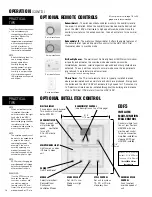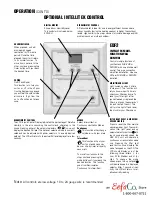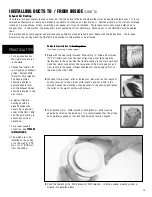
19
• For new construction,
the rigid ducts are run
in the walls.
• Choose the location for
your Supply and Exhaust
grilles - Fantech MGE
(metal) or PGE (plastic).
The Supply grilles
should be located in
every habitable room
and the Exhaust Grilles
should be located in the
wet rooms.
• A piece of flexible
ducting should be
placed between the
Supply Air In and Out
collar of the HRV / ERV
and the rigid ducting to
absorb any noise or
vibrations.
• For proper network
of ducting, see
TYPES OF
INSTALLATIONS.
• The grilles are to be
installed on the ceiling
or on the wall 6” (152
mm) to 12” (305 mm)
from the ceiling.
4
Push the Fantech grille - MGE (metal) or PGE (plastic) - into the optional mounting collar or
directly into installed elbow.
INSTALLING DUCTS TO / FROM INSIDE
(CONT'D)
PRACTICAL TIPS
2
Working from a closet, attic or inside your joist wall, run the length of
ducting required for the proper grille location and cut a hole in the
drywall. Fasten the mounting collar (optional) to the ducting and fasten
the collar to the wall or ceiling with screws.
3
The Fantech grille - MGE (metal) or PGE (plastic) - airflow can be
adjusted by rotating the inside unit. It is recommended that the grilles
be completely opened at first and then adjusted later as needed.
Dedicated Installation for Existing Home
-
(non forced air heating / cooling system)
1
Begin with the duct collar marked “Exhaust Air In”. Slide a short piece
(12”) of flexible duct over the duct collar. Using duct tape, tape the
flexible duct to the collar. Run the flexible ducting to the main rigid duct
trunk line, which connects to the remainder of the ducts going to and
from rooms in the house. Repeat the steps for the “Supply Air Out” on
the side of the HRV / ERV.
Exhaust Air Ducting
The stale air exhaust system is used to draw air from the points in the house where the worst air quality problems occur. It is rec-
ommended that return air ducts be installed in the bathroom, kitchen, and laundry room. Additional return air ducts from strategic
locations (i.e. greenhouse, atrium, swimming pool, sauna, etc.) may be installed. The furnace return duct may be also used to
exhaust from. In this method, the exhaust air is not ducted back from bathrooms, kitchens, etc to the HRV/ERV with “dedicated
lines”.
This method has become popular and provides good ventilation when installed in accordance with the instructions. The furnace
blower must be running when the HRV/ERV is operating for this method to be effective.




























